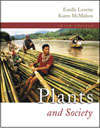
Materials: Cloth, Paper, and Wood |  |
Chapter Summary1. In addition to food and drink, plants furnish society with the raw materials to provide shelter, clothing, and paper. Plant fibers have been extracted and treated to weave cloth and manufacture rope for millenia. Cotton fiber is actually elongated seed hairs, and the techniques to render cotton fibers into cloth were discovered independently in both the Old and New Worlds. Gossypium hirsutum and G. barbadense, cotton species native to the New World, make the finest cotton cloth. These species are widely cultivated and have largely replaced Old World cultivars. The development of Eli Whitney’s cotton gin brought about the mechanization of cotton production and with it an increased demand for slave labor, setting the stage for the American Civil War in the 1860s.
2. Linen, made from bast fibers of flax (Linum usitatissimum) was the cloth of choice for many ancient civilizations. Retting uses microbial action to free the flax fibers from the stem.
3. Other bast fibers that have been used to make cloth are ramie, jute (burlap), and hemp. Manila hemp, piña, and sisal are leaf fibers that have been used to make cloth, as well as a variety of other products such as rope and mats. Kapok is a surface fiber too fine to be spun but useful as padding and stuffing; coir is a seed fiber from the coconut valued for ropes and mats. Rayon was the first of many artificial fibers; it is made from extracting cellulose from wood fibers and molding the cellulose into yarn.
4. Bark is another material that has been used to make cloth and paper. Examples are the kapa cloth of the native Hawaiians and the amate folk paintings of Mexico.
5. Wood and wood products supply construction materials and fuel to much of the world population. The strength of wood, its insulating properties, its versatility, and its natural beauty sustain the demand for lumber. Yet forestland is being lost at a rate that jeopardizes the future availability of wood. Pine and Douglas-fir are the leading softwoods produced in the United States. The greatest use of softwood lumber is for home construction. Oaks are the most economically important hardwoods in the United States, with white oak the most prized oak species. The wood is heavy, durable, and attractive. It is widely used in furniture, cabinets, and flooring. Black walnut, hickories, maples, sweetgum, and birches are other important hardwoods. Each year approximately 50% of the world’s wood harvest is used as fuel, especially in the developing nations. Over 2.5 billion people depend on wood or charcoal for the majority of their energy needs for heating and cooking. Other products from trees include resins and cork.
6. In industrialized nations, approximately 50% of the harvested wood goes into wood pulp, with the majority of pulp used in the manufacture of paper. Processing pulp removes the lignin. Although removing lignin is necessary to produce a quality writing paper, it has resulted in some environmental problems caused by disposing of the residue and by processing chemicals. It has been suggested that wood-rotting fungi may be able to substitute for some of the pollution-causing chemicals. In the United States each year about 1 billion trees are cut down to satisfy the demand for paper and paper products. Although most paper today is prepared from wood pulp, this source of pulp has been used only since the mid-nineteenth century. Many plant materials can supply pulp, including straw, leaves, or rags. Overuse of forest resources is renewing the search for alternative sources of pulp.
7. Bamboo is a treelike member of the grass family with a long history of use in construction, furniture, baskets, screens, carpets, paper, and food. The versatility of bamboo is due to the strong, lightweight stalks that have an astounding rate of growth. Bamboo species range from small plants to giant grasses and are found throughout the world. The greatest diversity of species occurs in China, producing about 300 species.
|
|
|